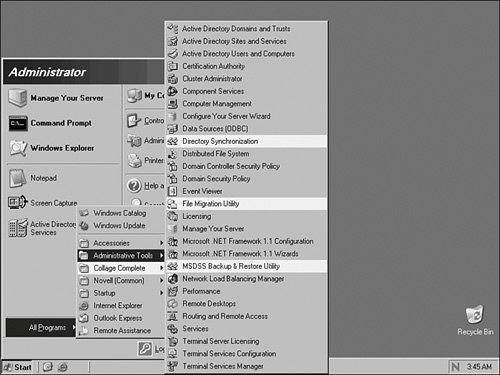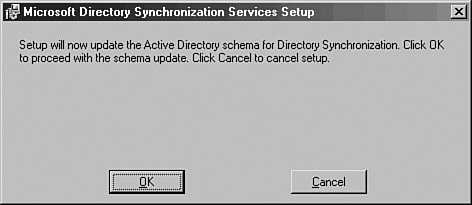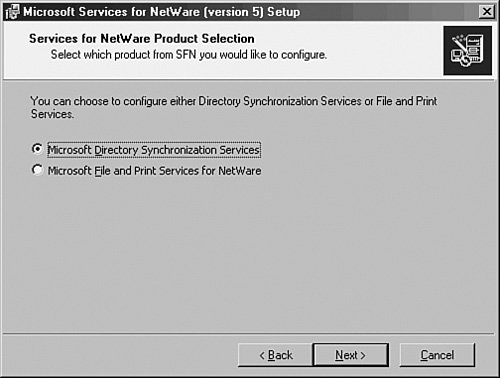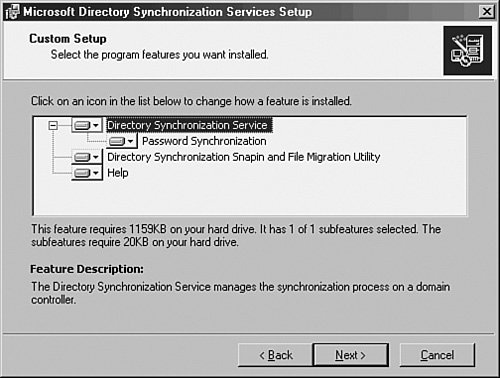Connecting Windows and NetWare Environments with Services for NetWare
| Microsoft has always been very good about offering utilities and services that migrate users off NetWare and onto the Windows network operating system (NOS). Interoperability with NetWare systems was not a high priority. Co-existence has become more streamlined since those days, however, with the development of the Gateway Services for NetWare (GSNW) and Services for NetWare (SFNW) utilities that make interoperability, as well as migration, more straightforward to accomplish. Gateway Services for NetWareIntegration of a Windows environment with Novell network operating systems is simplified through the use of Gateway Services for NetWare, a robust integration product that allows Windows Server 2003 to integrate and share resources with Novell NetWare. GSNW provides for the following functional elements:
Specific scenarios for GSNW include the following:
Note A Windows server running GSNW can provide only a single gateway to one NetWare server at a time. Multiple simultaneous connections are not supported. Using Services for NetWareServices for NetWare (SFNW) 5.02 Service Pack 2 (SP2) provides companies with the tools to integrate or migrate Novell users and resources to Windows environments. SFNW provides the following tools:
Note Older versions of Services for NetWare did not support Windows Server 2003. Service Pack 2 for SFNW 5.02 now supports installation on a Windows Server 2003 system. Installing Services for NetWare 5.03The installation of SFNW is not without its caveats. First and foremost, MSDSS needs to be installed on a domain controller and the forest schema of Active Directory needs to be extended. Because forest schema changes are not to be taken lightly, this factor alone warrants consideration before the installation procedure. After the schema has been upgraded, the base program can be installed and the latest service pack applied. To install SFNW, perform the following steps:
Figure 8.7. Choosing to extend the AD schema for MSDSS. Figure 8.8. Choosing to install MSDSS. Figure 8.9. Reviewing installation options for SFNW. Services for NetWare is now installed and ready for configuration. The applications will be listed under the Administrative Tools menu, as illustrated in Figure 8.10. Figure 8.10. Finding the Services for NetWare Admin tools. File and Print Services for NetWareFile and Print Services for NetWare is a back-end service that allows a Windows server to emulate a NetWare File and Print Server. NetWare clients can connect to the file and printer shares as if they were connecting to a Novell server. Novell clients use the same user interface to access file and printer resources running on an FPNW server. Essentially, FPNW allows an FPNW server to spoof an existing NetWare server after it has been retired, allowing administrators the time to gradually migrate desktops over to the Windows environment. Specific scenarios for FPNW include the following:
Microsoft Directory Synchronization ServicesMicrosoft Directory Synchronization Services (MSDSS) is a tool used for synchronization of directory information stored in the Active Directory and Novell Directory Services (NDS). MSDSS synchronizes directory information stored in Active Directory with all versions of NetWare; MSDSS supports a two-way synchronization with NDS and a one-way synchronization with Novell 3.x bindery services. Because Active Directory does not support a container comparable to an NDS root organization and because Active Directory security differs from Novell, MSDSS, in migration mode only, creates a corresponding domain local security group in Active Directory for each NDS organizational unit (OU) and organization. MSDSS then maps each Novell OU or organization to the corresponding Active Directory domain local security group. MSDSS provides a single point of administration. With a one-way synchronization, changes made to Active Directory will be propagated over to NDS during synchronization. Synchronization from Active Directory to NDS allows changes to object attributes, such as a user's middle name or address, to be propagated. In two-way synchronization mode, changes from NDS to Active Directory require a full synchronization of the object (all attributes of the user object). One of the key benefits to MSDSS is password synchronization. Passwords can be administered in Active Directory and the changes propagated over to NDS during synchronization. Password synchronization allows users access to Windows Server 2003 and NDS resources with the same logon credentials. The MSDSS architecture is made up of the following three components. These components manage, map, read, and write changes that occur in Active Directory, NDS, and NetWare bindery services.
In addition to the core components of MSDSS, the session configuration settings (session database) are securely stored in Active Directory. Specific scenarios for MSDSS would include the following:
Migrating Using the File Migration UtilityThe File Migration Utility is used to automatically manage the migration of files from NetWare file and print servers to Windows Server 2003 systems. Integrated with MSDSS, FMU copies files while preserving the permissions and access control lists (ACLs) associated with each file. FMU copies the file permissions using a user-mapping file that matches an NDS user account with an Active Directory account. Through this mapping file created with MSDSS, files and the rights inherited or assigned in NetWare are calculated and maintained in the Windows network, preserving security and minimizing the time-consuming process of reassigning file rights and permissions. Without the mapping file, FMU will assign file permissions on all migrated files to the administrator. Note The File Migration Utility will directly map the effective rights of NetWare file folders and files to Windows based on the closest Windows security equivalent. Because NTFS Security does not exactly match with Novell Security, there are some approximations done in this process that should be understood. |
EAN: 2147483647
Pages: 499


